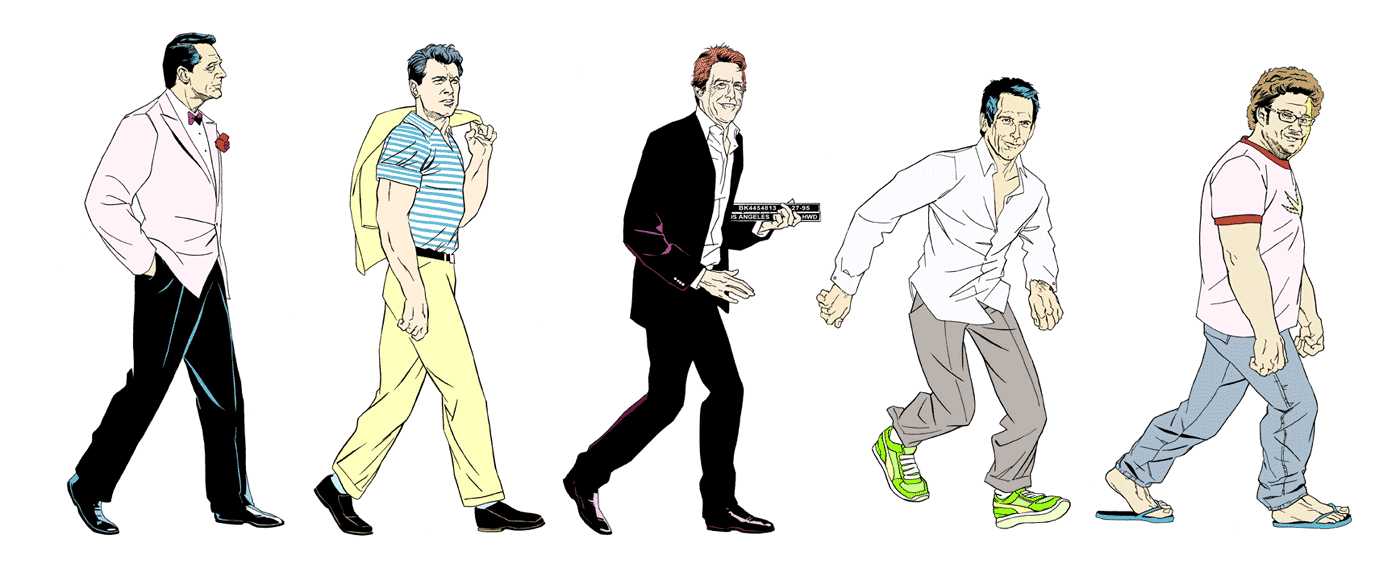In an illustration called "Evolution of the Leading Man," Bird captures not just the decline of the stature of movie leading men from Cary Grant to today, but of the overall decline into naturalism of art in general. (click image for full size)
 I think this is one of the reasons for the popularity of superhero movies. When the only options for leading men are fat, messy stoners on the one hand, and fantastical if often morally ambiguous superheros on the other, a lot of people are drawn to the latter if only to see the depiction of someone larger than life. We'll know things are getting better when we can reverse the regression and bring back romantic realism in movies, with new Cary Grants and Katherine Hepburns.
I think this is one of the reasons for the popularity of superhero movies. When the only options for leading men are fat, messy stoners on the one hand, and fantastical if often morally ambiguous superheros on the other, a lot of people are drawn to the latter if only to see the depiction of someone larger than life. We'll know things are getting better when we can reverse the regression and bring back romantic realism in movies, with new Cary Grants and Katherine Hepburns.
7 comments:
Fascinating post! It is clear, concise, and integrated--connecting wide abstractions to the particulars of attire and demeanor.
As a corollary, I wish some objective writer would begin writing a weblog reviewing fashion trends in the street and on the "runways" in designers' showrooms.
When I was still reading the news, I noticed a small sign of hope on the horizon (if it's true): On the designers' runways, the disheveled look of mismatched, unfitted clothing may be coming to an end. If the photos in the New York Times are a guide to that splinter of culture, a more coordinated, integrated look may be emerging here and there. If so, bravo!
Excellent observation!
It's fascinating how a relatively simple image can capture a profound abstraction.
I don't recognise the third guy, with the red hair, but the last two are comedics actors. Comedic actors are naturally going to look funny. Shouldn't this be compared with the more serious and best paid actors like Will Smith and Brad Pitt, who have perfect bodies and have their fair share of roles as moral characters.
Tenure, I understand what you're saying, but when I look at the drawing, I see a common thread between all the actors. During their periods of stardom, they have all had famous and prominent roles in romantic comedies.
Cary Grant - His Girl Friday (1940)
Rock Hudson - Pillow Talk (1959)
Hugh Grant - Four Weddings and a Funeral (1994)
Ben Stiller - There's Something About Mary (1998)
Seth Rogen - Knocked Up (2007)
You're right that there are current actors who aren't the buffoons that Stiller and Rogen are. But if you look at romantic comedies as a whole, and look at their sense of life and the leading characters in them from 1940 to now, the trend it obvious. The drawing depicts this trend rather well.
In the interest of full disclosure, I quite enjoy most of Hugh Grant's movies. Despite the fact that he was arrested with a prostitute (thus the mug shot nameplate he's holding) most of his movies like Notting Hill, About a Boy, and even Music & Lyrics, are smart, funny, and much closer to the comedies from the Golden Age than most are today.
I wouldn't want to mess up your blog by posting the following in 72 point Times Roman, but I want to:
Bravo!
To me personally, as someone who has seen literally thousands of films from 1929 to the present (the overwhelming majority pre-1965), this devolution is far and away the most depressing aspect of modern life, much more so than the horrendous economic events of the past few decades.
That cartoon describes the reason much more succinctly than I ever could.
Thanks.
Thanks for the comment, Jeff. I wouldn't mind if you posted a giant "bravo", but I think blogger would cruelly and unfairly strip away your font tags.
It sounds like the drawing struck you in the same way as it did me. One of the real "picture worth 1,000 words" things, and like Stephen said above "a relatively simple image can capture a profound abstraction."
For Cary Grant, his heyday mid 1930s to early 1940s movies I've seen so far are "Holiday" (co-starring Katharine Hepburn), "The Awful Truth," "The Philadelphia Story" (co-starring Katharine Hepburn and James Stewart), "Suspicion" (directed by Alfred Hitchcock), and "His Girl Friday." I recommend them all. What are your favorites? Off the top of my head, "Holiday," "Suspicion," and "The Philadelphia Story" are mine so far.
Post a Comment